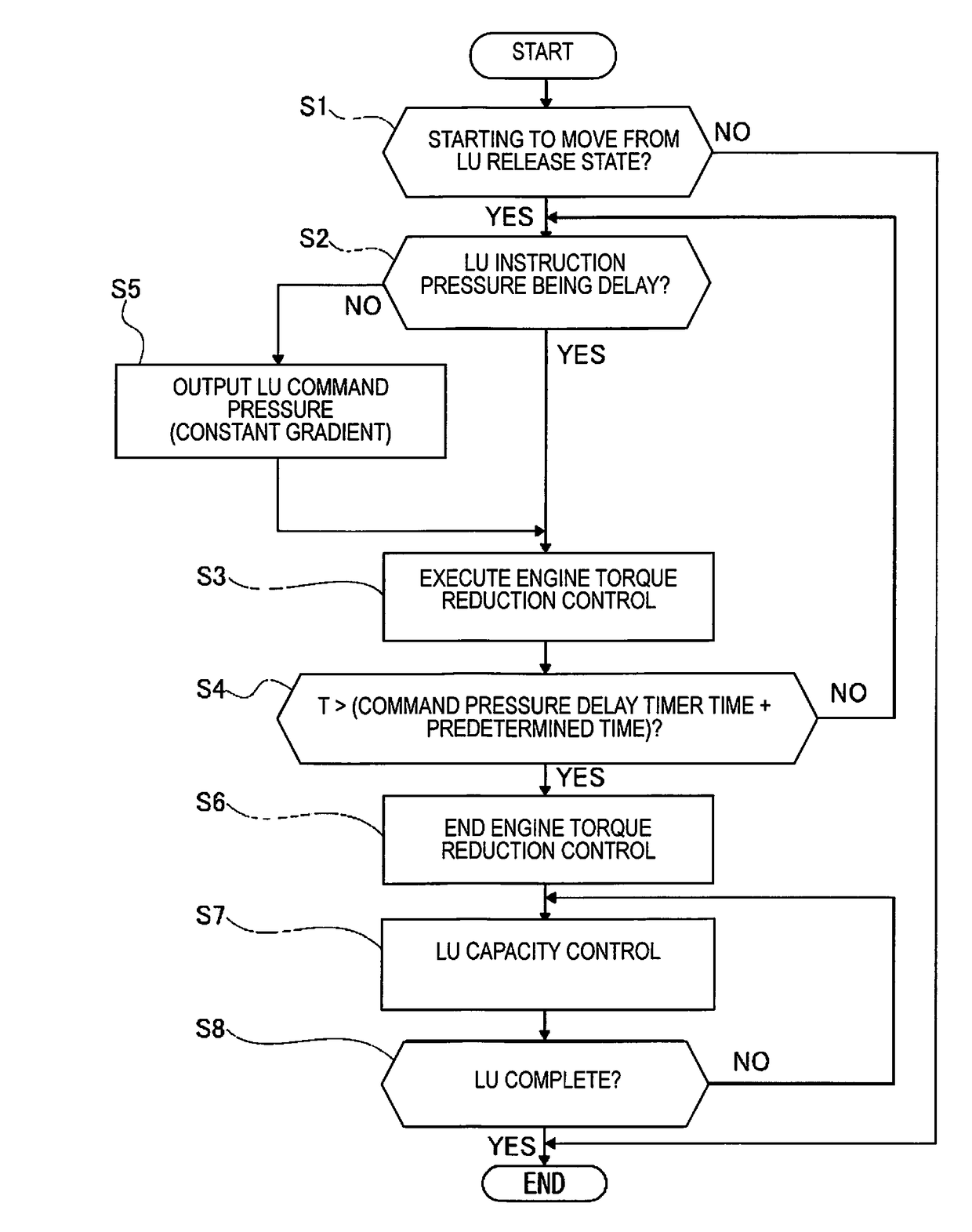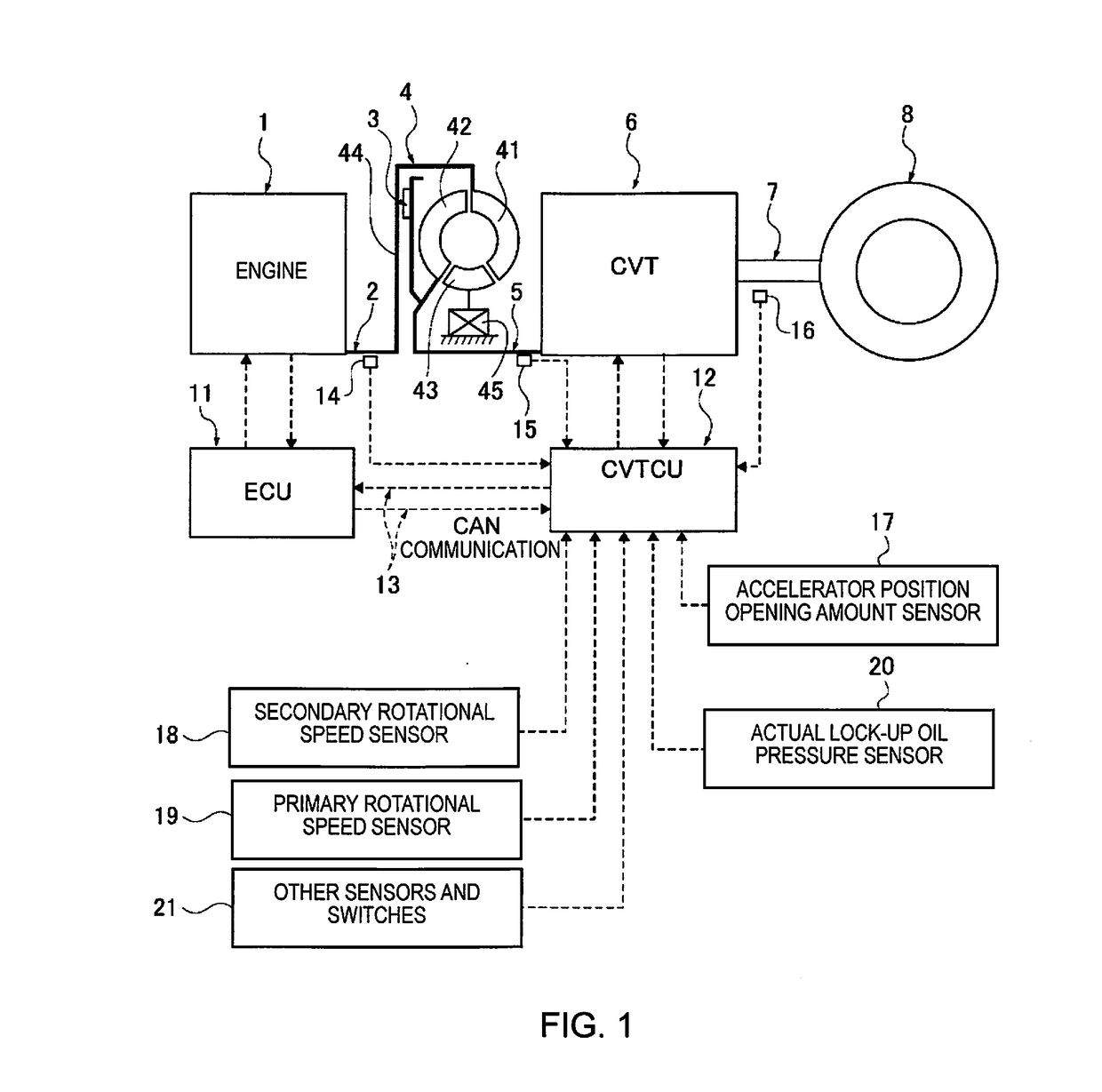Vehicle lock-up clutch control device
a clutch control and clutch technology, applied in the direction of clutches, gearing elements, gearing, etc., can solve the problems of engine racing, lock-up capacity not being generated, shock, etc., and achieve the effect of reducing engine torque, reducing engine racing, and delay in lock-up command pressur
- Summary
- Abstract
- Description
- Claims
- Application Information
AI Technical Summary
Benefits of technology
Problems solved by technology
Method used
Image
Examples
first embodiment
[0018]The configuration is described first. The “Overall system configuration” and the “Initial-motion lock-up control configuration” will be separately described regarding the configuration of the lock-up clutch control device for a vehicle in the first embodiment.
Overall System Configuration
[0019]FIG. 1 illustrates an engine-equipped vehicle to which is applied a lock-up clutch control device of the first embodiment. The overall system configuration will be described below, based on FIG. 1.
[0020]As illustrated in FIG. 1, a vehicle drive system comprises an engine 1, an engine output shaft 2, a lock-up clutch 3, a torque converter 4, a transmission input shaft 5, a continuously variable transmission 6 (transmission), a drive shaft 7 and a drive wheel 8.
[0021]The lock-up clutch 3, built into the torque converter 4, couples the engine 1 and the transmission 6 via the torque converter 4 by releasing the clutch, and directly connects the engine output shaft 2 and the transmission input...
second embodiment
[0058]The second embodiment is an example in which the lock-up capacity generation timing to end the engine torque reduction control is determined by a change rate condition.
[0059]The configuration is described first. FIG. 6 illustrates the flow of the initial-motion lock-up control process that is executed by the CVT control unit 12 according to the second embodiment (initial-motion lock-up control means). Each step in FIG. 6 showing the configuration of the initial-motion lock-up control process will be described below. Since each of the steps of Step S21-Step S23 and Step S25-Step S28 are steps that carry out the same processes as each of the steps of Step S1-Step S3 and Step S5-Step S8 in FIG. 2, the descriptions thereof are omitted.
[0060]In Step S24, following the execution of the engine torque reduction control in Step S23, it is determined whether or not a change rate condition of either an engine rotational speed change rate being greater than or equal to a predetermined val...
third embodiment
[0064]The third embodiment is an example in which the lock-up capacity generation timing to end the engine torque reduction control is determined by a lock-up pressure condition.
[0065]The configuration is described first. FIG. 7 illustrates the flow of the initial-motion lock-up control process that is executed by the CVT control unit 12 according to the third embodiment (initial-motion lock-up control means). Each step in FIG. 7 showing the configuration of the initial-motion lock-up control process will be described below. Since each of the steps of Step S31-Step S33 and Step S35-Step S38 are steps that carry out the same processes as each of the steps of Step S1-Step S3 and Step S5-Step S8 in FIG. 2, the descriptions thereof are omitted.
[0066]In Step S34, following the execution of the engine torque reduction control in Step S33, it is determined whether or not a lock-up pressure condition of either the lock-up command pressure exceeding a constant value, or the actual lock-up oi...
PUM
 Login to View More
Login to View More Abstract
Description
Claims
Application Information
 Login to View More
Login to View More - R&D
- Intellectual Property
- Life Sciences
- Materials
- Tech Scout
- Unparalleled Data Quality
- Higher Quality Content
- 60% Fewer Hallucinations
Browse by: Latest US Patents, China's latest patents, Technical Efficacy Thesaurus, Application Domain, Technology Topic, Popular Technical Reports.
© 2025 PatSnap. All rights reserved.Legal|Privacy policy|Modern Slavery Act Transparency Statement|Sitemap|About US| Contact US: help@patsnap.com



